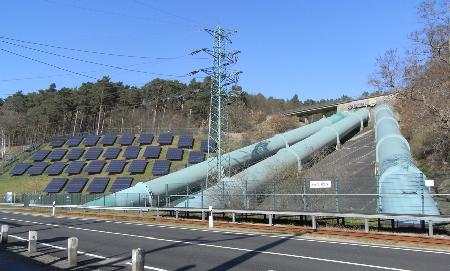
An energy facility in Germany, where energy from solar cells pumps water up to a reservoir during the day. During the night it flows down again through turbines, to generate electricity.
The main challenge for solar power is to get costs down so that they are comparable with mainstream energy sources. Economies of scale are already bringing down the cost dramatically, while improving technology also helps to make it cheaper.
One of the obvious challenges of solar power is that it is only available when the sun is shining. Even when the sky is overcast the amount of useful energy is much reduced.
For solar cells for example, energy generated during the day needs to be stored until the evening. Some projects pump water up into a dam during the day, and then let the water run down during the night through electricity-generating turbines. Others use, for example, flywheels to store the energy.
Solar thermal power stations may be able to get around this problem by storing the hot liquids they generate, such as molten salt, for generating electricity later when it is dark. Also for artificial photosynthesis systems which split water into hydrogen and oxygen, the hydrogen can be stored until it is needed.
Another problem: solar cells generates direct current, rather than the alternating current which is used in almost all power distribution networks. This may also be a feature given that many modern electrical devices, such as computers, require direct current anyway. The grid could also be modified to DC.
The pictured energy park is Geesthacht in Schleswig-Holstein, Germany.
Author: Tom Brown
Copyright: public domain
Date last modified: 13th Oct 2011
Peer-review status: Not yet peer-reviewed
energy park: source: Wikipedia, copyright: CC?